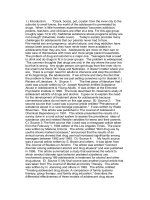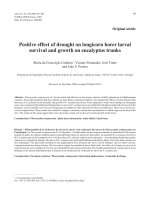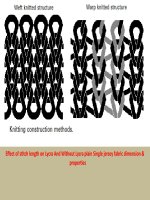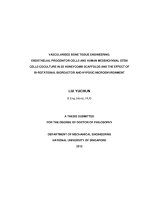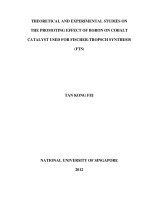Effect of dietary supplementation of ginger and cinnamon on growth performance and economics of broiler production
Bạn đang xem bản rút gọn của tài liệu. Xem và tải ngay bản đầy đủ của tài liệu tại đây (236.57 KB, 9 trang )
Int.J.Curr.Microbiol.App.Sci (2019) 8(3): 1849-1857
International Journal of Current Microbiology and Applied Sciences
ISSN: 2319-7706 Volume 8 Number 03 (2019)
Journal homepage:
Original Research Article
/>
Effect of Dietary Supplementation of Ginger and Cinnamon on Growth
Performance and Economics of Broiler Production
D.S. Gaikwad1,2*, Y.G. Fulpagare2, U.Y. Bhoite2, D.K. Deokar2 and C.A. Nimbalkar2
1
2
Lovely Professional University, G.T. Road Phagwara, Punjab 144411, India
Department of Animal Husbandry and Dairy Science, PGI, Mahatma Phule Krishi
Vidyapeeth, Rahuri- 413 722 (M.S)-India
*Corresponding author
ABSTRACT
Keywords
Broiler, Cinnamon,
Ginger,
Supplementation,
Production,
Economics
Article Info
Accepted:
15 February 2019
Available Online:
10 March 2019
The 140 day old „Vencob-400‟ chicks, which were divided into seven treatment groups
with four replicates per group (Five chicks per replicate) i.e. 20 chicks per treatment
groups. Dietary treatments consisted of basal diet T 0 (Control), T1, T2 and T3 with T4, T5
and T6consist of 1, 2 and 3 per cent cinnamon while 1, 2 and 3 per cent ginger,
respectively. Body weight and feed consumption were recorded at weekly interval. Feed
conversion ratio, dressing percentage, economics of broiler production were calculated.
Cinnamon and ginger feeding were done separately and compared by completely
randomized design (CRD). The body weight of the 2.0% (T2) cinnamon and 1% ginger
(T4) group was significantly (P≤0.05) higher than the other groups. The average feed
consumption was significantly highest (3966.85 g/b) in control group and lowest (3793.30
± 05.94 g/b) in 2.0% cinnamon (T 2) supplemented group. No mortality was observed
entire experiment. Highest profit per bird was observed in T 4 (Rs. 24.17) followed by T 2
(21.15), T1 (18.27) and other treatments while lowest in T 3 (8.47).Similarly highest cost
benefit ratio was found in T 4 supplemented with 1% ginger powder followed by T 2, T1, T5,
T0, T3 and T6. From the result of present study it was concluded that dietary inclusion of
2.0 % cinnamon and 1.0 % ginger can be used as growth promoters for more profit per
bird.
Introduction
India is the fourth-largest chicken producer in
the world after China, Brazil and the USA.
The consumption of chicken meat in India
increased from 400 g. per annum, to 2.5 kg per
annum in the last five years (Poultry Sector,
2017). Poultry ration (feed) is important and
major component of poultry farming, because
of 80% cost only for procurement of feed
(Asghar et al., 2003). In the past, antibiotics
were the most routinely used feed additives in
poultry ration. Antibiotics is not only limited
but their use in livestock and poultry industry
also have been banned in many countries due
to the reasons like alteration of natural gut
microbiota and drug resistance As a result, to
replace
them
without
affecting
the
performance of poultry birds, natural growth
promoters such as prebiotics, probiotics,
1849
Int.J.Curr.Microbiol.App.Sci (2019) 8(3): 1849-1857
synbiotics, enzymes, plant extracts and natural
medicinal products etc., can be used in poultry
ration (Borazjanizadeh et al., 2011).
intake and feed conservation ratio in broilers.
ii) Study the growth performance of broilers.
iii) Study the economics of broiler production.
Ginger and cinnamon are natural growth
promoters and can be potential alternatives for
common artificial growth promoters like
antibiotics (Demir et al., 2003). Ginger is the
rhizome of the plant Zingiber officinale,
consumed as a delicacy, medicine or spice.
Preliminary research indicates that nine
compounds found in ginger may bind to
serotonin receptors which may influence
gastrointestinal
function.
Research
conducted in-vitro shows that ginger extract
might control the quantity of free radicals and
the peroxidation of lipids (Al-Amin et al.,
2006) and have anti-diabetic properties
(Morakinyo et al., 2011).
Materials and Methods
Cinnamon (Cinnamomum cassia) commonly
known as “dalchini” is important medicinal
plants and widely used in India. It belongs to
the Lauracea family and is native of Sri Lanka
and South India (Jakhetia et al., 2010).
Cinnamons possess appetite and digestion
stimulant properties (Taback et al., 1999).
Many essential oils have been extracted from
the
cinnamon
like
cinnamic
acid,
cinnamaldehyde, cinnamate, caryophyllene
oxide, eugenol and L-borneol (Tung et al.,
2008). Cinnamaldehyde having antibacterial
(Chang et al., 2001), antioxidant properties
(Singh et al., 2007) and other medicinal
properties like antiulcer, anti-diabetic, antiinflammatory which have recently been
reviewed by Jakhetia et al., (2010).
Considerable attention has been paid to the
role of nutritional manipulation in minimizing
the total feed cost of production, increasing
weights, dressing percentage, feed conversion
and economics of broiler production. Keeping
the above information in view, the present
study was conducted on broilers with the
following objectives, i) Study the effect of
ginger and cinnamon supplementation on feed
The trial was conducted on 140 day old,
Vencobb-400 broiler chicks at Poultry Unit,
Veterinary Polyclinic and AI Center MPKV,
Rahuri-413
722,
Dist.
Ahmednagar,
Maharashtra. The cinnamon and ginger
powder was procured from local market. The
140 birds were divided in to 7 treatment group
with four replicates of 5 chicks each and
housed under deep litter system. The T0 birds
were fed on a basal ration (Control),T1 Basal
ration + 1 % Cinnamon (i.e. 10 g/ kg of feed),
T2 Basal ration + 2 % Cinnamon powder (i.e.
20 g/kg of feed), T3 Basal ration + 3 %
Cinnamon powder (i.e. 30 g/kg of feed), T4
Basal ration + 1 % Ginger powder (i.e. 10
g/kg of feed), T5 Basal ration + 2 % Ginger
powder (i.e. 20 g/kg of feed) and T6 Basal
ration + 3 % Ginger powder (i.e. 30 g/kg of
feed). Immediately arrival of chicks were
weighed and distributed randomly in to 7
treatment groups viz, T0, T1, T2 and T3, T4, T5
and T6 with 20 chicks in each group, on body
weight basis.
Body weight and feed consumption were
recorded at weekly interval up to 6th weeks of
age. Feed conversion efficiency was estimated
as quantity (kg) of feed consumed for every kg
gain in body weight. Performance efficiency
(%) was calculated as the ratio of body weight
(kg) and feed conversion efficiency (kg),
multiplied by 100. At the end of trial, three
birds from each group were randomly selected
and slaughtered for estimating dressing
percentage. The economics of broiler
production was worked out by considering the
total cost of production which included the
feed cost, chicks, labour, medicines, vaccines
and
the
overhead
costs.
Proximate
composition of broiler ration and feed
1850
Int.J.Curr.Microbiol.App.Sci (2019) 8(3): 1849-1857
additives analysis was carried out as per the
method given in A.O.A.C., 2005.The data
were analyzed by standard statistical
techniques (Snedecor and Cochran, 1994).
Results and Discussion
The data pertaining to growth performance
and allied traits as influenced by dietary
cinnamon and ginger supplementation in
broiler chickens are elucidated here under.
Chemical composition of experimental feed
ingredients (%DM basis)
The experimental feeds viz. broiler starter and
finisher which were supplemented with
cinnamon and ginger powder as per treatment
details. The proximate composition of the
rations is presented in Table 1.
dry matter, crude protein, crude fiber, ether
extract, ash and nitrogen free extract,
respectively. Composition of cinnamon
powder observed in the present investigation
was similar to that reported by Najafi and
Taherpour et al., (2014) as 92.50, 4.10, 45.30,
1.70, 4.40 and 37.00 per cent of dry matter,
crude protein, crude fiber, ether extract, ash
and nitrogen free extract, respectively.
Ademola, et al., (2009) reported that
composition of ginger was 87.39, 1.35, 5.85,
2.93, 2.29 and 87.58 per cent of dry matter,
ether extract, crude protein, crude fiber, ash
and nitrogen free extract, respectively.
Body weight changes (g)
The crude protein, crude fiber, ether extract,
total ash, nitrogen free extract and acid
insoluble ash of finisher ration were 20.00,
3.78, 4.30, 6.85, 65.15 and 1.44 per cent
respectively and calculated metabolizable
energy (ME) of the diet was 2939.75 Kcal/kg.
The data on body weight is presented in Table
2, which indicate the highest live weight (g)
was obtained in T2 (2408.5 ± 22) followed by
T4 (2376.75 ± 25.26), T5 (2326.20 ± 24.13), T6
(2300.4 ± 25.81), T1 (2300.08 ± 23.19), T3
(2290.05 ± 26.89) and T0 (2169.05 ± 11.18)
treatments. The zero days average live weights
of each treatment were comparable. The final
body weight of birds was significantly
(P≤0.05) higher in all supplemented treatment
groups in comparison to control. This result
was in line with the finding of Sang-oh et al.,
(2013) who reported that, the body weight of
the cinnamon powder groups were increased
significantly (P<0.05) when compared to the
control group. Farinu et al., (2004) also
reported that supplementation of ginger at the
levels of 5, 10, or 15 g/kg of feed slightly
improved growth in broilers. In constant, ElDeek et al., (2002) observed that a diet
containing ginger at the rate of 1 g/kg of feed
did not affect growth performance.
Proximate composition of feed additives
Body weight gain (g)
Composition of Ginger powder observed in
the present investigation was in agreement
with Najafi and Taherpour et al., (2014) who
reported that composition of ginger was 91.00,
10.20, 18.30, 3.20, 4.90 and 54.60 per cent of
The data on body weight (Table 3) that
average gain in body weight in treatment T4
(633.60 ± 32.53 g) group was significantly
(P≤0.05) higher over other treatments. Then
followed by T6 (563.90 ± 27.00 g), T3 (542.45
Starter ration
The crude protein, crude fiber, ether extract,
total ash, nitrogen free extract and acid
insoluble ash of starter ration were 23.00,
4.60, 4.80, 7.20, 60.40 and 1.25 per cent
respectively and calculated metabolizable
energy (ME) of the diet was 2863.811
Kcal/kg.
Finisher ration
1851
Int.J.Curr.Microbiol.App.Sci (2019) 8(3): 1849-1857
± 33.00 g), T2 (501.85 ± 32.06, T0 (499.18 ±
18.51 g), T1 (476.98 ± 25.56 and T5 (476.70 ±
25.23). Sang et al., (2013) who concluded that
cinnamon treated birds had higher body
weight gain. Najafi and Taherpour (2014)
showed the dietary ginger inclusion leads to
significantly (P<0.05) higher body weight
gain.
the effect of herb ginger powder on increasing
levels of dietary herb ginger powder caused a
significant reduction in feed consumption.
Feed efficiency
It was evident from the table 5 that treatment
T0 (1.87 ± 0.01) showed lowest feed
efficiency level whereas, T4 (1.65 ± 0.02)
showed the highest. Data in table 5 indicated
that supplementation of 1.0% ginger powder
in broilers diet was significantly superior to
rest of the treatments. The findings of present
study were in accordance with results reported
by Kausar et al., (1999) and Moorthy et al.,
(2009), Najafi and Taherpour (2014).
Cumulative feed consumption (g)
The cumulative feed intake (Table 5) was
significantly (P≤0.05) improved from 21st day
of age. It was evident from the table that
average feed consumption vary significantly
(P≤0.05) from control group. However, it was
observed that either the cinnamon or ginger
powder supplementation from 1, 2 and 3 %, in
both the supplements the feed intake was
significantly less at 2.0% (T2 and T5). Present
findings were in agreement with, Arshad et
al., (2012) who concluded that addition of
ginger extract in poultry diet reduced the feed
intake. Barazesh et al., (2013) reported that
Dressing percentage
The average dressing percentage (Table 4)
among the different treatments groups varied
between 77.04 ± 0.02 to 78.69 ± 0.08 per cent.
The differences among all the treatment
groups were found significant (P≤0.05).
Table.1 Per cent chemical composition of experimental broiler ration on dry matter basis
Nutrients
Crude protein
Crude fiber
Ether extract
Total ash
Nitrogen free extract
Acid insoluble ash
ME (Kcal/kg)
Broiler ration
Starter
Finisher
23.00
20.00
4.60
3.78
4.80
4.30
7.20
6.85
60.40
65.15
1.25
1.44
2863.811
2939.75
Table.2 Proximate composition (%) of experimental feed additives on dry matter basis
Plant
Products
Ginger
Cinnamon
DM
CP
CF
EE
Ash
NFE
89.00
91.50
9.20
3.90
17.30
45.20
3.00
1.80
4.10
4.30
66.40
44.80
1852
Int.J.Curr.Microbiol.App.Sci (2019) 8(3): 1849-1857
Table.3 Broilers traits in different groups of chicks up to 6th weeks of age
Treat
Body Weight
Weight Gain
Feed Intake
T0
2169.05a
± 11.18
2300.08b
± 23.19
2408.50d
± 22.00
2290.05b
± 26.89
2376.75cd
± 25.26
2326.20bc
± 24.13
2300.40b
± 25.81
2310.15
± 23.16
499.18a
± 18.51
476.98a
± 25.56
501.85a
± 32.06
542.45a
± 33.00
633.60b
± 32.53
476.70a
± 25.23
563.90ab
± 27.00
527.81
± 28.12
3966.85c
± 15.01
3849.05b
± 13.33
3793.30a
± 05.94
3804.40a
± 05.64
3842.45b
± 10.25
3809.35a
± 09.74
3860.10b
± 11.44
3846.50
± 10.70
T1
T2
T3
T4
T5
T6
Mean
FCR
1.87c
± 0.01
1.75ab
± 0.02
1.71b
± 0.04
1.72ab
± 0.02
1.65a
± 0.02
1.67a
± 0.02
1.72ab
± 0.02
1.72
± 0.02
Values bearing different superscripts in column differ significantly (P≤0.05)
Table.4 Effect of supplementation cinnamon and ginger on dressing percentage (without skin)
Treatment
T0
Mean Dressing Percentage
77.04 ± 0.02a
T1
78.36 ± 0.39d
T2
78.66 ± 0.17cd
T3
77.40 ± 0.09ab
T4
78.69 ± 0.08c
T5
78.12 ± 0.01d
T6
77.90 ± 0.04bc
Values bearing different superscripts in column differ significantly (P≤0.05)
1853
Int.J.Curr.Microbiol.App.Sci (2019) 8(3): 1849-1857
Table.5 Effect of supplementation of cinnamon and ginger on weekly cumulative feed
consumption (g)
Sr. No.
1.
2.
3.
4.
5.
6.
7.
8.
9.
10.
11.
12.
13.
14
Particulars
Cost of day old chick (Rs.)
Cost of feed (Rs/kg)
Cost of Ginger and Cinnamon
Powder (Rs/Bird)
Total cost of feed (Rs/kg)
Average total feed consumed
per bird (Kg)
Cost of feed consumed per bird
(Rs.)
Average body weight at the end
of 6th week (Kg)
Feed consumption per kg live
weight gain (Kg)
Cost of feed per kg live weight
gain (Rs.)
Rearing Cost per bird (Rs.)
Total cost of production (Rs.)
(1+6+10)
Average price realized @ Rs.
65 per kg live weight (Rs.)
Net profit per bird (Rs.) (12-11)
Cost benefit ratio
T0
18
27
0.00
T1
18
27
1.38
T2
18
27
2.89
T3
18
27
4.12
T4
18
27
1.18
T5
18
27
2.32
T6
18
27
3.45
27
3.966
28.38
3.849
29.89
3.793
31.12
3.804
28.18
3.842
29.32
3.809
30.45
3.86
107.9
109.2
113.4
118.4
108.3
111.7
117.5
2.169
2.300
2.408
2.290
2.376
2.326
2.300
1.828
1.673
1.575
1.661
1.617
1.638
1.678
49.36
47.49
47.08
51.69
45.57
48.01
51.10
4
129.9
4
131.2
4
135.4
4
140.4
4
130.3
4
133.7
4
139.5
140.99 149.5 156.52 148.85 154.44 151.19 149.5
11.09
1.09
18.27
1.14
21.15
1.16
8.47
1.06
24.17
1.19
17.51
1.13
Values bearing different superscripts in column differ significantly (P≤0.05)
Fig.1 Effect of cinnamon and ginger on cost benefit ratio at the end of experiment
1854
9.96
1.07
Int.J.Curr.Microbiol.App.Sci (2019) 8(3): 1849-1857
Highest dressing percentage was recorded in
the treatments T4 (78.69 ±0.08) and T2 (78.66
±0.17) which were at par to each other.
Herawati and Marjuki (2011) showed broilers
given ration with red ginger showed
significantly higher dressed weight (P≤0.05).
Park et al., (2013) observed that the dressing
percentage were significantly higher in the
CNP (Cinnamon powder) groups than the
control group (77.08).
Economics of broiler production
The cost of feed (Table 3) in T1, T2, T3, T4, T5
and T6 increased in accordance with the level
of addition of cinnamon powder and ginger
powder. Moreover, broilers in treatment
groups T2 gained highest body weight
(2408.50 ± 22.00 g) with feed cost of Rs.
113.40 and lowest in T0 (control) group
gained weight (2169.05 ± 11.18 g) with feed
cost Rs. 107.90 (Fig. 1). Present findings are
in agreement with, Ahmed et al., (2006);
Mohamed and Yusuf (2011); Arshad et al.,
(2012); Elmakki et al., (2013); Hossain et al.,
(2014; Oleforuth-okoleh et al., (2014)
reported that increased economic efficiency of
broilers diet supplemented with ginger. The
highest cost benefit ratio was found in T4
supplemented with 1% ginger powder
followed by T2, T1, T5, T0, T3 and T6.
In conclusion, the effect of dietary
supplementation
of
ginger
(Zingiber
officinale) and cinnamon (Cinnamomum
zeylanicum) on growth performance indicated
that 2.00 % of cinnamon powder or 1.00 % of
ginger powder had significantly higher body
weight and weekly gain in body weight along
with better feed conversion. Highest dressing
percentage in T4 and T2 group as compare to
other treatment group. The highest cost
benefit ratio was found in T4 supplemented
with 1% ginger powder as compared to other
treatment groups and control. Hence, it was
concluded that inclusion of 2 % cinnamon and
1.0 % ginger can be used as growth
promoters.
References
Ademola, S.G., Farinu, G.O., Babatunde, G.
M., (2009). Serum lipid, growth and
hematological parameters of broilers fed
Garlic, Ginger and their mixtures.
World J. Agric. Sci. 5(1):99-104.
Ahmed, M.R.O., Hala, M., Wahed, A.E. and
Mona, S.R. (2006). Performance and
carcass characteristics of broiler chicks
fed diets supplemented with some
medicinal and aromatic plants. Poult.
Sci. 85, 1128-1132.
Al-Amin ZM, Thomson M, Al-Qattan KK,
Peltonen-Shalaby R, Ali M. (2006).
Anti-diabetic
and
hypolipidaemic
properties
of
ginger
(Zingiber
officinale) in streptozotocin-induced
diabetic rats. Br J. Nutr. 96(4), 660-666.
AOAC (2005). Association of Official
Analytical Chemists. Official Method of
Analysis. Washington, DC.
Arshad, M., Kakar, A.H., Durrani, F.R.,
Akhtar,
A.,
Shakirullah,
S.,
Niamatullah, M. (2012). Impact of
Ginger
(Z.
Economical
and
immunological officinale) extract on
broiler chicks. Pakistan J. Sci. 64(1),
46-48.
Asghar, A., Farooq, M., Mian, M.A.,
Khurshid, A. (2003). Economics of
broiler production of Mardan division.
J. Rural Dev. 32(3), 56–65.
Barazesh, H., Mohammad B. P., Somaye, S.,
Tahereh M. A. (2013). The effect of
ginger powder on performance, carcass
characteristics and blood parameters of
broilers. Int. J. Adv. Bio. and
Biomedical Res. 1(12), 1645-1651.
Borazjanizadeh, M., Eslami, M., M, Chaji M.,
Fayazi, J. (2011). The effect of clove
and oregano on economic value of
broiler chickens diet under hot weather
of Khuzesta. J. Anim. Vet. Adv. 10(2),
169–173.
Chang, S.T., Chen, P.F., Chang, S.C. (2001).
1855
Int.J.Curr.Microbiol.App.Sci (2019) 8(3): 1849-1857
Antibacterial Activity of Leaf Essential
Oils and Their constituents from
Cinnamomum osmophloeum. J. of
Ethno pharmacology. 77, 123-127.
Daghir, N.J. (2009). Nutritional Strategies to
Reduce Heat Stress in Broilers and
Broiler Breeders. Lohaman Information.
44(1), 6.
Demir, E., Sarica, S., Ozcan, M.A, Suicmez,
M. (2003). The use of natural feed
additives as alternatives for an antibiotic
growth promoter in broiler diets. Br. J.
Poult. Sci. (44), 44–45.
El-Deek, A.A., Attia, Y.A., Maysa, M.,
Hannfy, M. (2002). Effect of anise
(Pimpinella anisum), ginger (Zingiber
officinale
Roscoe)
and
fennel
(Foeniculum vulgare) and their mixture
on performance of broilers. Arch.
Geflügelkd. 67, 92–96.
Elmakki, A. M., AbdelAtti A. K, Dousa M.
B., Elagib A. A. H., Malik E. E. H, and
Elamin M. K. (2013). Effect of Treated
Cowpea Seeds on Broiler Chicken.
Global Journal of Animal Scientific
Research. 1(1), 76-83.
Farinu, G.O., Ademola, S.G., Ajayi Obe,
A.O., Babatunde, G.M. (2004). Growth,
haematological and biochemical studies
on garlic and ginger-fed broiler
chickens. Moor J. Agric. Res. 5, 122–
128.
Hashemi S.R., Davoodi, H. (2010).
Phytogenics as New Class of Feed
Additive in Poultry Industry. J.Ani.Vet.
Adv. 9, 2295-2304.
Herawati and Marjuki (2011). The Effect of
Feeding Red Ginger (Zingiber officinale
Rosc.) as phytobiotic on Broiler
Slaughter Weight and Meat Quality. Int.
J. Poult. Sci. 10(12), 983-985.
Hossain, M.M. Howlader, A.J. Islam, M.N.,
Beg, M.A.H. (2014). Evaluation of
locally available herbs and spices on
physical, biochemical and economical
parameters on broiler production. Inter.
J. Plant Ani. Environ. Sci. 4(1), 317323.
Jakhetia, V., Patel, R., Khatri, P., Pahuja, N.,
Garg, S., Pandey, A., Sharma, S.
(2010). Cinnamon: a pharmacological
review. J. Adv. Sci. Res. 1,19-23.
Kausar, R., Rizvi, F., Anjum, A.D. (1999).
Effect of carminative mixture on health
of broiler chicks. Pakistan J. Biol. Sci.
2(3), 1074-1077.
Mohammed, A. A., Yusuf, M. (2011).
Evaluation
of
ginger
(Zingiber
officinale) as a feed additive in broiler
diets. Livestock Research for Rural
Development. Volume 23, Article #202.
/>2.htm.
Moorthy, M., Ravi, S., Ravi kumar, M.,
Viswanathan, K., Edwin, S.C. (2009).
Ginger, Pepper and Curry Leaf powder
as feed additives in broiler diet. Int. J.
Poult. Sci. 8(8), 779-782.
Morakinyo A.O, Akindele A.J, Ahmed Z.
2011. Modulation of antioxidant
enzymes and inflammatory cytokines:
Possible mechanism of anti-diabetic
effect of ginger extracts. Afr. J. Biomed.
Res. 9, 195–202.
Najafi, S. and Taherpour, K. (2014). Effects
of Dietary Ginger, Cinnamon, Synbiotic
and Antibiotic supplementation on
performance of broilers. J. Anim. Sci.
Adv. 4(1), 658-667.
Oleforuh-Okoleh, V.U., Chukwu, G.C. and
Adeolu, A.I. (2014). Effect of ground
Ginger and Garlic on the growth
performance, carcass quality and
economics of production of broiler
chickens. Global J. Bio. Sci. and
Biotech. 3(3), 225-229.
Park, B.S. (2008). Effect of dietary cinnamon
powder on savor and quality of chicken
meat in broiler chickens. J. Korean Soc.
Food Sci. Nutr. 37(5), 618-624.
Poultry
Sector
in
India.
2017.
/>
1856
Int.J.Curr.Microbiol.App.Sci (2019) 8(3): 1849-1857
17/05/.
Sang-oh, P., Chae-Min, R., Byung-Sung, P.
and Jong, H. (2013). The meat quality
and growth performance in broiler
chickens fed diet with cinnamon
powder. J. Envi. Bio. 34, 127-133.
Singh, G., Maurya, S., Cesar, M.P., Catalan,
A.M. (2007). A comparison of
chemical, antioxidant and anti-microbial
studies of cinnamon leaf and bark
volatile oils, oleoresins and their
constituents. Food and Chemical
Toxicology. 45, 1650-1661.
Snedecor, G. W., Cochran, W. G. (1994).
Statistical methods (8th Ed.). The Iowa
state college perss, Ames, IOWA,
Oxford and I. B. H. publication Co.,
Calcutta.
Taback, M., Armon, R., Neeman, I. (1999).
Cinnamon extracts inhibitory effect on
Hellcobater pylori. J. Ethnopharmacol.
67, 269-277.
Tung, Y.T., Chua, M.T., Wang, S.Y., Chang,
S.T.
(2008).
Anti-inflammatory
activities of essential oil and its
constituents from indigenous cinnamon
(Cinnamon osmophloeum) Twigs Bio
resource Tech. 99, 3908-3913.
How to cite this article:
Gaikwad, D.S., Y.G. Fulpagare, U.Y. Bhoite, D.K. Deokar and Nimbalkar, C.A. 2019. Effect
of Dietary Supplementation of Ginger and Cinnamon on Growth Performance and Economics
of Broiler Production. Int.J.Curr.Microbiol.App.Sci. 8(03): 1849-1857.
doi: />
1857


